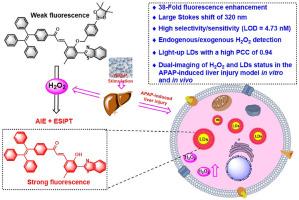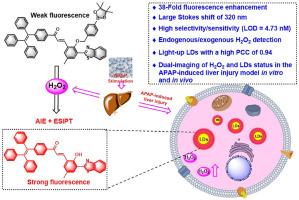An activatable “AIE + ESIPT” fluorescent probe for dual-imaging of lipid droplets and hydrogen peroxide in drug-induced liver injury model
IF 5.7
2区 化学
Q1 CHEMISTRY, ANALYTICAL
引用次数: 0
Abstract
Background
Drug-induced liver injury (DILI) is one of the most common liver diseases. The crucial role of lipid droplets (LDs) and hydrogen peroxide (H2O2), two important biomarkers in the pathophysiology of DILI, has spurred considerable efforts to accurately visualize H2O2 and LDs for elucidating their functions in the progression of DILI. However, construction of a single fluorescent probe that is able to simultaneously image H2O2 and LDs dynamics remains to be a challenging task. Therefore, it is of great demand to develop a novel fluorescent probe for tracking the LDs status and H2O2 fluctuation in drug-induced liver injury.
Results
We developed an “AIE + ESIPT” fluorescent probe TPEHBT for dual-imaging of LDs and H2O2 during DILI process. TPEHBT displayed greatly enhanced fluorescent response to H2O2 by generating an excited state intramolecular proton transfer (ESIPT) fluorophore TPEHBT-OH with aggregation induced emission (AIE) properties. TPEHBT exhibits high selectivity, sensitivity (LOD = 4.73 nM) and large Stokes shift (320 nm) to H2O2. Interestingly, TPEHBT can light up LDs with high specificity. The probe was favorably applied in the detection of endogenous and exogenous H2O2 in living cells, and notably in the simultaneous real-time visualization of H2O2 generation and LDs accumulation during DILI process. Moreover, TPEHBT was able to image H2O2 generation in zebrafish animal model with APAP-induced liver injury.
Significance
For the first time, probe TPEHBT was applied in the dual-imaging of H2O2 fluctuation and LDs status in APAP-induced liver injury model in vitro and in vivo. The present findings strongly suggest that TPEHBT is a promising tool for monitoring H2O2 and LDs dynamics in DILI progression.


一种可激活的 "AIE + ESIPT "荧光探针,用于对药物诱导的肝损伤模型中的脂滴和过氧化氢进行双重成像
背景药物性肝损伤(DILI)是最常见的肝病之一。脂滴(LDs)和过氧化氢(H2O2)是 DILI 病理生理学中两个重要的生物标志物,它们在 DILI 的发展过程中起着至关重要的作用。然而,构建能够同时成像 H2O2 和 LDs 动态的单一荧光探针仍然是一项具有挑战性的任务。因此,开发一种新型荧光探针来追踪药物性肝损伤中的 LDs 状态和 H2O2 波动是非常有必要的。通过生成具有聚集诱导发射(AIE)特性的激发态分子内质子转移(ESIPT)荧光团 TPEHBT-OH,TPEHBT 对 H2O2 的荧光响应大大增强。TPEHBT 对 H2O2 具有高选择性、高灵敏度(LOD = 4.73 nM)和大斯托克斯偏移(320 nm)。有趣的是,TPEHBT 能以高特异性点亮 LD。该探针可用于检测活细胞中的内源性和外源性 H2O2,特别是在 DILI 过程中同时实时观察 H2O2 的产生和 LDs 的积累。意义首次将探针 TPEHBT 应用于 APAP 诱导的肝损伤模型体内外 H2O2 波动和 LDs 状态的双重成像。本研究结果有力地表明,TPEHBT 是监测 H2O2 和 LDs 在 DILI 进展过程中动态变化的一种有前途的工具。
本文章由计算机程序翻译,如有差异,请以英文原文为准。
求助全文
约1分钟内获得全文
求助全文
来源期刊

Analytica Chimica Acta
化学-分析化学
CiteScore
10.40
自引率
6.50%
发文量
1081
审稿时长
38 days
期刊介绍:
Analytica Chimica Acta has an open access mirror journal Analytica Chimica Acta: X, sharing the same aims and scope, editorial team, submission system and rigorous peer review.
Analytica Chimica Acta provides a forum for the rapid publication of original research, and critical, comprehensive reviews dealing with all aspects of fundamental and applied modern analytical chemistry. The journal welcomes the submission of research papers which report studies concerning the development of new and significant analytical methodologies. In determining the suitability of submitted articles for publication, particular scrutiny will be placed on the degree of novelty and impact of the research and the extent to which it adds to the existing body of knowledge in analytical chemistry.
 求助内容:
求助内容: 应助结果提醒方式:
应助结果提醒方式:


